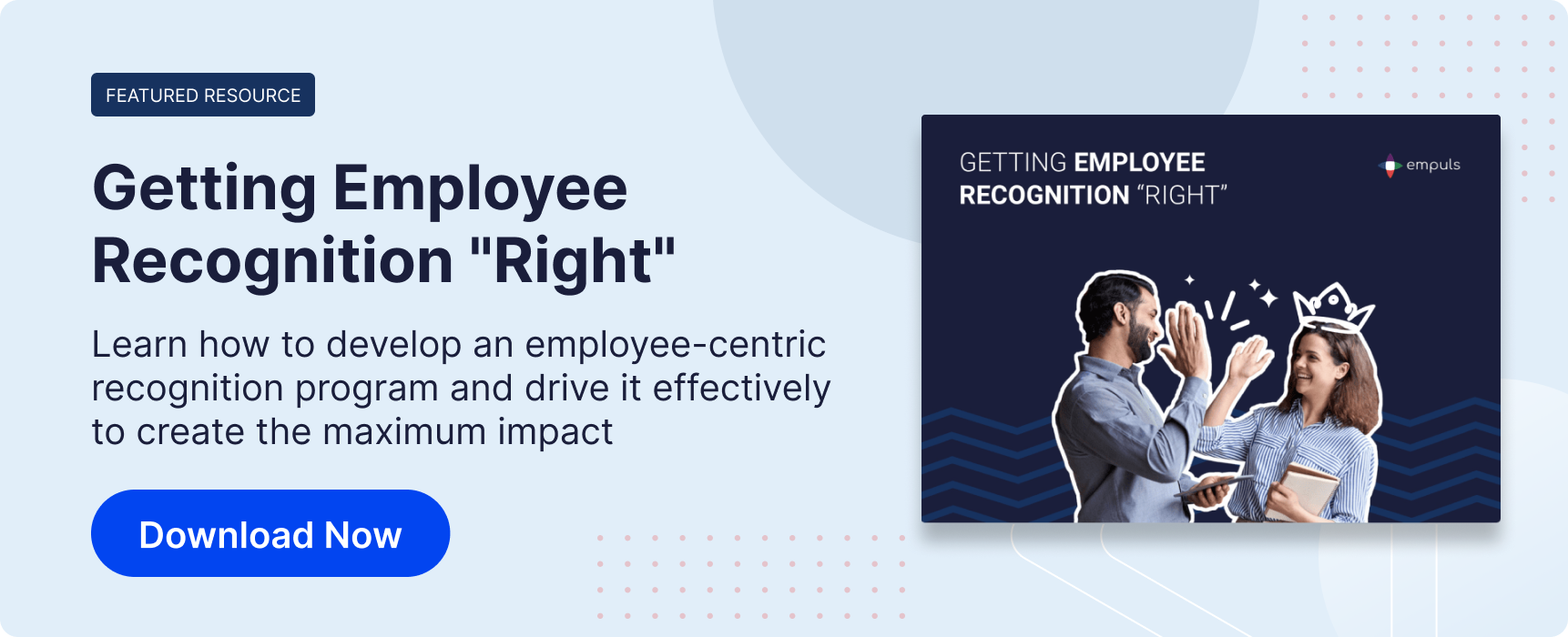10 Statistik Pengiktirafan Pekerja Global Utama
Pengiktirafan pekerja adalah cara yang sistematik untuk membuka potensi penuh tenaga kerja anda. Berikut ialah cara statistik pengiktirafan pekerja berbaris di peringkat global.
Pada halaman ini
Syarikat sentiasa mencari cara untuk meningkatkan produktiviti keseluruhan dan garis bawah mereka. Pengiktirafan pekerja tetap menjadi strategi perniagaan penting yang perlu dipertimbangkan oleh setiap syarikat, dan saya akan memberitahu anda mengapa.
Ini menunjukkan bahawa syarikat yang tidak mengiktiraf pekerja mereka kemungkinan besar akan mengalami kos perolehan yang tinggi - antara 5.8 peratus hingga 213 peratus daripada gaji pekerja, bergantung kepada kemahiran pekerjaan dan pekerja.
Selain kos penggantian langsung, kos lain yang berkaitan termasuk kehilangan produktiviti dan masa, liputan sementara, dan latihan pekerja baru.
Fikirkan bagaimana kos tersebut jika lebih daripada seorang pekerja meninggalkan syarikat! Inilah sebabnya mengapa pemimpin HR dan perniagaan perlu memberi perhatian lebih kepada statistik pengiktirafan pekerja.
Kami telah mengumpulkan senarai statistik pengiktirafan pekerja utama yang perlu diketahui oleh setiap pemimpin HR. Anda akan mendapati maklumat berguna semasa anda membuat kes perniagaan untuk program pengiktirafan pekerja syarikat anda.
Statistik pengiktirafan pekerja dengan jelas mewajarkan mengapa penting untuk mempunyai kategori ganjaran dan pengiktirafan yang berbeza untuk pekerja di syarikat anda.
10 Statistik pengiktirafan pekerja utama
Untuk memudahkan anda, kami telah mengumpulkan senarai 10 statistik pengiktirafan pekerja utama yang mesti anda ketahui.
Mari kita menyelam.
1. Lebih satu pertiga daripada semua responden berkata tugas mereka adalah sumber tekanan biasa.
Tempat kerja boleh menyebabkan tekanan yang ketara bagi ramai pekerja. Di kalangan milenium dan Gen Zers, penduduk yang mengalami tekanan kerja kronik meningkat kepada 44 peratus.
Tekanan yang berlebihan boleh, seterusnya, membawa kepada keletihan, yang menelan kos ekonomi global kira-kira £ 255 bilion.
Mengetahui fakta-fakta ini, syarikat dapat meningkatkan kesihatan mental pekerja dengan mewujudkan budaya pengiktirafan dan memberi tumpuan kepada inisiatif kesejahteraan sebagai sebahagian daripada pakej ganjaran keseluruhan mereka.
Pengiktirafan pekerja membantu memotivasi pekerja dan memupuk rasa bangga dan terima kasih di dalamnya. Akibatnya, pekerja berasa lebih bahagia dan produktif di tempat kerja.
2. Di peringkat global, satu daripada empat pekerja sangat bersetuju bahawa mereka telah menerima pengiktirafan atau pujian kerana melakukan kerja yang baik pada minggu lepas.
Perhatikan bahawa salah satu soalan tinjauan pengiktirafan pekerja Q12 Gallup bertanya sama ada responden telah menerima pujian dalam tujuh hari terakhir.
Mengikut amalan terbaik, pengiktirafan pekerja harus kerap dan diberikan tepat pada masanya. Jika anda mengetuai pasukan 10 orang, statistik pengiktirafan pekerja ini menunjukkan bahawa sekurang-kurangnya dua pekerja telah menerima pengiktirafan kerana melakukan kerja yang baik dalam tujuh hari terakhir.
Bahaya untuk tidak mengenali pekerja anda, menurut Gallup, adalah bahawa "pekerja yang tidak merasa diiktiraf secukupnya adalah dua kali lebih mungkin untuk mengatakan bahawa mereka akan berhenti pada tahun depan."
Oleh itu, adalah penting untuk sentiasa mengenali pekerja dan rakan sebaya anda atas sumbangan bermakna mereka ke tempat kerja.
3. Menurut laporan mengenai statistik pengiktirafan pekerja, 56 peratus profesional HR bersetuju bahawa program pengiktirafan mereka mempunyai kesan positif terhadap pengambilan pekerja.
Apabila syarikat mewujudkan budaya positif untuk pekerja sedia ada, di mana mereka diiktiraf atas sumbangan mereka, pekerja akan membantu mempublikasikan syarikat mereka sebagai tempat yang bagus untuk bekerja.
Selalunya, calon yang luar biasa memilih untuk bekerja untuk sebuah syarikat berdasarkan faktor-faktor di luar pampasan-mereka menilai nilai, misi, dan unsur-unsur budaya lain.
Oleh kerana orang adalah empat kali lebih cenderung untuk membeli [jenama anda] apabila dirujuk oleh rakan-rakan, reputasi positif dapat memudahkan untuk menarik calon peringkat tinggi ke syarikat anda.
Akibatnya, syarikat akan menjimatkan masa dan kos dalam usaha pengambilan mereka.
4. 27 peratus pekerja di negara yang berbeza menunjukkan kekurangan pengiktirafan dan ganjaran sebagai alasan penting untuk meninggalkan majikan.
Dalam laporan global 2018 mereka, Randstad membentangkan pandangan penting daripada kaji selidik terhadap lebih 175,000 responden di 30 negara.
Menurut laporan ini, salah satu faktor yang mendorong pekerja menjauhi syarikat ialah kurangnya pengiktirafan dan ganjaran.
Jelas sekali, pengiktirafan pekerja adalah strategi pengekalan, dan pekerja yang merasa dihargai akan kekal di pekerjaan mereka. Juga, program pengiktirafan global membawa keluar yang terbaik dalam orang dan mendorong mereka untuk melakukan yang lebih baik dalam peranan mereka.
Syarikat-syarikat yang bergelut untuk mengekalkan pekerja perlu mempertimbangkan cara kreatif untuk mengenali pekerja mereka dan memastikan terdapat peluang untuk pembangunan profesional pekerja.
5. Penglibatan, produktiviti dan prestasi pekerja adalah 14 peratus lebih tinggi daripada organisasi tanpa pengiktirafan.
58 peratus profesional HR mengesyorkan agar pemimpin mengenali dan memuji pekerja mereka lebih kerap untuk membantu mendorong penglibatan.
Dalam erti kata lain, pengiktirafan pekerja adalah menang-menang untuk semua orang. Pekerja mengalami peningkatan semangat dan bermotivasi untuk meningkatkan prestasi kerja mereka, sementara syarikat mengalami peningkatan prestasi secara keseluruhan.
6. 79 peratus milenium mengatakan bahawa peningkatan pengiktirafan akan menjadikan mereka lebih setia kepada majikan mereka.
Ramai milenium membesar menerima pujian berterusan daripada ibu bapa mereka, menunjukkan bahawa mereka membuat kemajuan dan melakukan sesuatu yang bermakna.
Jangkaan milenium terhadap pujian tetap tidak berbeza di tempat kerja. Millennials ingin tahu bahawa sumbangan mereka penting dan mereka mengharapkan untuk menerima pengiktirafan segera untuk melakukannya.
Walau bagaimanapun, kebanyakan milenium tidak berpuas hati dengan program ganjaran dan pengiktirafan syarikat mereka. Ini bermakna pendekatan tradisional atau satu saiz yang sesuai untuk pengiktirafan pekerja bukanlah pendekatan yang tepat untuk digunakan dengan milenium.
Untuk menarik golongan milenial dan mengekalkan mereka untuk seketika, pastikan mereka melakukan kerja yang bermakna dan menerima maklum balas dan pengiktirafan segera dan tetap untuk sumbangan mereka.
7. 28 peratus pekerja mendedahkan bahawa pengiktirafan yang paling tidak dapat dilupakan datang dari pengurus mereka.
Menurut kaji selidik pengiktirafan pekerja Gallup, 28 peratus responden bersetuju bahawa pengiktirafan mereka yang paling tidak dapat dilupakan datang dari pengurus mereka. Sebagai perbandingan, 24 peratus bersetuju bahawa mereka datang dari CEO atau pemimpin peringkat tinggi.
Analisis itu menambah bahawa "pekerja akan mengingati maklum balas peribadi daripada CEO... Malah, pengakuan daripada seorang CEO boleh menjadi kemuncak kerjaya." Mengikut maklumat ini, seseorang akan bersandar memihak kepada struktur pengiktirafan pengurus-pekerja.
Walau bagaimanapun, adalah penting untuk membuat pengiktirafan pekerja pelbagai arah-dari pemimpin perniagaan, pengurus, rakan sebaya, atau laporan langsung. Ia membolehkan peluang untuk mendapatkan maklum balas bulat daripada semua orang pekerja bekerja rapat, termasuk pihak luar.
8. Hampir 90 peratus pekerja yang menerima pengiktirafan atau terima kasih daripada bos mereka pada bulan lalu menunjukkan tahap kepercayaan yang lebih tinggi terhadap bos itu.
Apabila pemimpin mengiktiraf pekerja atas sumbangan mereka, mereka secara positif mengukuhkan tingkah laku yang diingini, menjadikan mereka merasa dihargai, dan mewujudkan persekitaran kepercayaan.
Juga, kepercayaan penting di tempat kerja kerana ia menjadikan pekerja lebih inovatif dan produktif-mereka boleh memberikan prestasi terbaik mereka, yang akhirnya meningkatkan keuntungan.
9. Menurut laporan mengenai penghargaan pekerja, 85 peratus profesional ingin mendengar "terima kasih" dalam interaksi sehari-hari.
Penghargaan memainkan peranan besar dalam melibatkan pekerja. Menurut pandangan dari Kimia Perniagaan Deloitte, "pekerja hari ini mahukan hubungan dengan majikan mereka yang diperibadikan, fleksibel, dan disesuaikan, dan mereka ingin merasa dihargai dan dihargai untuk apa yang mereka lakukan."
Mengatakan "terima kasih" adalah cara mudah untuk menghargai pekerja di tempat kerja—dan ia boleh dinyatakan melalui kad, mesej, hadiah atau kad hadiah.
10. Ramai pekerja jarak jauh - walaupun masih bekerja - mungkin merasa hanyut, hilang, dilupakan dalam persekitaran kerja baru mereka.
Sebelum pandemik, ramai pekerja jarak jauh telah melaporkan perasaan ditinggalkan dan tidak diiktiraf oleh rakan sejawatan mereka di pejabat.
Walau bagaimanapun, disebabkan pandemik, peratusan pekerja sepenuh masa yang bekerja dari rumah telah meningkat di seluruh dunia. Tidak menghairankan bahawa ramai pekerja jarak jauh merasa dilupakan.
Majikan boleh menangani isu ini dengan menawarkan cara mudah kepada pekerja untuk mengiktiraf sumbangan masing-masing dan memanfaatkan platform teknologi untuk menjadikannya proses yang demokratik, lancar dan telus.
Kesimpulan
Mudah-mudahan, anda telah menemui statistik pengiktirafan pekerja ini berguna dalam memahami kepentingan pengiktirafan pekerja dan membantu anda merancang program pengiktirafan pekerja yang baik yang boleh memberi kesan kepada keputusan kewangan syarikat anda.













